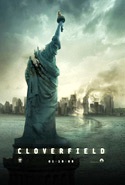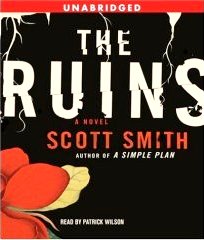I watched There Will Be Blood (Paul Thomas Anderson, 2007) on Tuesday night. Based on the novel Oil by Upton Sinclair, Anderson’s film features a Daniel Day-Lewis as fine as he could be; his performance is chilling. His body language, demeanor, and speech pattern transform him into a wiry late 19th and early 20th Century man of ambition and muted compassion. He’s no space heater, but as the protagonist of the film, he is viewed much more sympathetically than the antagonists, for instance, one Eli Sunday (Paul Dano).

Zack Haddad’s review at Film Threat notes that “the cinematography…is breathtaking…. The soundtrack is something to applaud as well. Jonny Greenwood, of Radiohead fame, puts together an ominous score that adds so many layers to the film, making it just that more haunting,” and “there hasn’t been such an amazing character study in film since ‘Citizen Kane’.”
The music is truly integral to creating the psychological tone of the piece and the cinematography reminded me of Hungarian films I’d seen by Miklos Jancso and Bela Tarr.
Trailer for There Will Be Blood
Clip from Jancso’s film The Red and the White.
Clip from Tarr’s film The Werckmeister Harmonies.

I watched Cloverfield last night. Producer JJ Abrams’s name has been attached to this film in every press mentioning, but he didn’t direct it. A Matt Reeves did.
Bronsonfive summarizes the film’s visual style and story as “think Blair Witch meets Godzilla (1954), and since that isn’t the first or last time you’ll see or read that comparison, think of a movie that results in something less profound than either.”
There isn’t likely to be another film pairing to describe Cloverfield, but for me, I’d call it any child under the age of five allowed to handle a camcorder…visually speaking. On the plot front, Pete Vonder Haar of Film Threat packages it succinctly as “a going-away party for 20-something New Yorker Rob (Michael Stahl-David), poised to assume a VP position with a company in Japan, is interrupted by a rampaging behemoth hell-bent on taking a very large bite out of the Big Apple, sending a group of friends fleeing through the city.”
Cloverfield is Blair Witch times five on the shaken-and-stirred, and though it simulates the usurpation of point-of-view (as Blair Witch did), there’s a subtle difference in the consequences and implications of the way in which Cloverfield is presented on screen. The “fake documentary” and “footage found” as a narrative device made me more uncomfortable when watching Cloverfield. The home-video aspect* of the story (not just how the film looks) removes the viewer’s ability to choose his visual and psychological surrogate. Hud is delegated the task of filming the going away party and does a steadfast job at it–in that he’s holding onto the camera nearly every step of the way from hands-on to eventual hands-off.
While the Blair Witch Project also consisted of subjective points-of-view, the camera was handed off to the three characters frequently enough so that you felt like you had a choice in which character to live through vicariously. More importantly, though, the voyeuristic quality didn’t feel forced (not to me at least). Furthermore, it was more clinical and exhibited a greater distance between viewer and subject. The Blair Witch characters were making a documentary and were applying standard cinematic techniques; Cloverfield‘s Hud was just holding a piece of equipment that could record sound and moving imagery–without giving a horse’s patoot about holding the damn thing still.
Aside from the virtually constant shaking, rattling, and rolling (narratively justified or not), what really bothered me about the film (and which ultimately makes it intellectually appetizing) is that there were no traditional reverse-shots. Certain characters would enact the “don’t film me, okay fine film me, but now it’s my turn to film you”…and then you are allowed to get the other angle, the reverse shot. Other than those instances, though, the film forces you to look ahead–literally. The camera might turn around to reveal the source of a commotion or to follow a character’s gaze, but depriving you of that reverse shot corners you into the position of whoever is holding the camera. If I had a choice in the matter, I wouldn’t want to be Hud. I’d much rather be Beth.
Bronsonfive ponders in his review: “All we know of them is what the camcorder tells us. The development of these characters is non-existent because it seems that this movie isn’t about them. This tape is played in the exact condition the government found it in. It’s an interesting gimmick that has worked well in other films, but doesn’t really solidify a purpose here. Were the filmmakers ashamed of their creature? They couldn’t actually think that we’d give a shit about these kids, could they?”
I believe a level of default concern is achieved precisely through the employment of point-of-view I discussed in the paragraph above. You care not because you want to–you care because you don’t have any other options (but I suppose this realization can only be reached if you over-analyze the way voyeurism functions in the film O1o).
Now, as for the meaning of the word “Cloverfield,” it appears in a title card in the beginning of the eighty-four minute long film. For those that don’t want to read more on this matter, do not highlight the relevant words after the colon: the title card indicates that Central Park was destroyed and renamed something like Area 4551 or something to that effect. Specifically, per Pete Vonder Haar’s review, “The monster’s origin remains a mystery, and no speculation is offered as to where it might have come from. This is a necessary result of the filmmakers’ presentation (everything we see is part of footage from a Defense Department presentation dubbed ‘Project: Cloverfield,’ recovered from a tape found at “the site formerly known as Central Park”), though viewers who like narrative resolution may be a little irritated.“
Political readings and allegories are certainly plausible here, but I will avoid them. I shall only add that the images of characters are running and crouching behind cars on Manhattan’s streets can refer to the chaos of living in a city where gunfire and tanks are a daily occurrence.
*The film begins with footage that includes a date and time for when the “home video” was being recorded. As you are watching the footage and noticing that the video isn’t cutting (there are no edits), you might also notice that the time will elapse much faster than real-time (that is if you glance between your own watch and the time on the video, the minutes on the video will go by faster than what your watch suggests).
~!~!~!~!~!~!~!~!~!~!~!~

About a year ago, I bought the audio book version of Scott Smith’s book The Ruins (Patrick Wilson narrated). I thought it would make an interesting movie and was imagining the cast possibilities. Well, one of the previews that came with the Cloverfield screening last night was, you guessed it, the film version. The preview suggests certain character and plot changes that will surely invite the scorn of Scott Smith fans. The book is very suspenseful and even scary, but it’s also quite sad–something which may be sacrificed in its celluloid variation.
Click here for the trailer.
